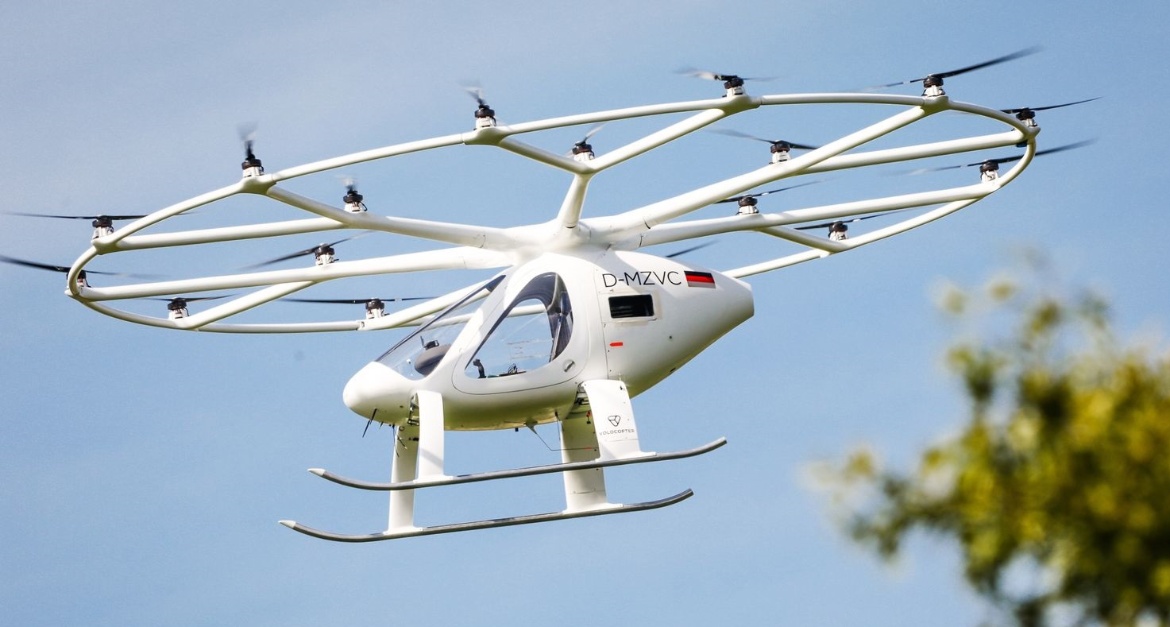Motivation
The multicopter concept, which is very popular with small drones, has been heavily adapted in recent years for the usage in heavier man-carrying transport vehicles, for example as air taxis. Such concepts further enhance the pure multicopter configuration by adding elements like airfoils or tilting mechanisms. All concepts, however, share the ability to take-off and land vertically, which is why these vehicles belong to the group of VTOL (Vertical Takeoff and Landing) vehicles. Due to this ability the requirements regarding physical infrastructure like runways are very low. Thus, VTOL vehicles are expected to substantially contribute to handling the increasing amount of traffic in densely populated urban areas (Urban Air Mobility).
Recent VTOL concepts are based on the principle of distributed propulsion by using at least four but mostly more propellers to generate lift and forward thrust. Due to this redundancy safety against failure of single actuators is enhanced and the controllability of the vehicles after a failure is ensured. In order to avoid complex mechanical linkages and to keep (noise) emissions low, most concepts rely on electric motors for propulsion. Such electrically driven VTOL vehicles are abbreviated as eVTOL.
Due to the specific configurations and use cases of eVTOL vehicles there are multiple new challenges and opportunities with regards to flight mechanics and flight control that serve as a starting point for further scientific research.
Research Activities
The Institute of Flight Mechanics and Flight Control is involved in multiple projects in the context of Urban Air Mobility. Partnering with leading international eVTOL developers, the institute participates in the development of the required flight control algorithms to ensure the safe and automatic flight of such vehicles. These algorithms are tested both on small-scale models as well as prototype vehicles with a takeoff mass of multiple hundreds of kilograms.
The institute, for example, cooperated with Volocopter in order to develop the flight controls for the VC200 and 2X vehicles. The iFR delivered major parts of the flight control algorithms that are used to stabilize the vehicle and realize the desired attitude and altitude commanded by the pilot via a control stick. Furthermore, the iFR developed a method to efficiently control the 18 redundant electric motors, hereby, for example, ensuring a uniform discharge of the battery packs and avoiding electrical imbalances. The algorithms of the iFR were successfully tested in numerous flights and were also used during the public flight of a Volocopter in Stuttgart in September 2019.
Together with Airbus Helicopters the iFR developed the software for the Automatic Flight Control System (AFCS) of the CityAirbus demonstrator, which has a takeoff mass of over 2 tons. The work covered the basic stabilization of the vehicle (attitude control) as well as the upper-level automatic modes. These modes allow easy piloting as the pilot can comfortably command desired velocities via a command stick and the AFCS automatically adjusts the vehicle’s attitude as required. Once the stick is let go, the algorithms ensure that the CityAirbus holds its resulting position and altitude and reliably suppresses any disturbances like wind gusts. Notably, the automatic modes developed by the iFR also allow the CityAirbus to take off and land automatically with the push of a button (ATOL). In addition, multiple methods and solutions were implemented in order to automatically initiate necessary corrective actions without pilot intervention in the event of failures (e.g. loss of datalink to the ground control station). Thus, the flight can be continued safely and a safe landing is ensured. During multiple test flights both at the Airbus site Donauwörth and the Drone Center Manching the developed AFCS including automatic take-offs and landings was successfully tested. The project concluded in July 2021 with the final flight of the CityAirbus demonstrator.
Many eVTOL concepts envision to operate vehicles neither with a pilot onboard nor having a pilot permanently operate a remote control. The iFR is also involved in the research and development of the algorithms that are required for such a level of autonomy. Algorithms developed by the iFR, for example, allow an eVTOL vehicle to autonomously follow a trajectory (three-dimensional path with defined time profile).
In order to ensure the quality and reliability of the development process for eVTOL vehicles by using the appropriate validation and verification measures, the Institute of Flight Mechanics and Flight Control uses, amongst others, the recommendations of well-established aerospace standards like ARP4754A and RTCA DO-178C.
Objectives
The goal of the activities at the Institute of Flight Mechanics and Flight Control with regards to the topic of eVTOL are the development and testing of
- methods to efficiently use the degrees of freedom provided by the redundant propulsion units when generating the control commands while also considering secondary objectives (e.g. balanced discharge of batteries).
- flight control algorithms and assistance systems that enable even those without intensive flight training to pilot an eVTOL vehicle in an intuitive and simpe way. At the same time it shall be ensured that all required safety requirements are complied with automatically and the comfort of ride of the passengers is considered.
- algorithms that enable an autonomous flight of eVTOLs without the need for a pilot (including takeoff and landing).
- emergency procedures in case of a technical failure that automatically execute the necessary correcting actions and ensure safe return to a landing spot.
Publications
- Welsch und W. Fichter, "Ground-Based Turn Coordination for VTOL Vehicles with Wind Compensation," in AIAA Scitech 2021 Forum, 2021
- Stephan und W. Fichter, "Active Battery Charge Drift Stabilization for Redundant Multirotors," in AIAA Scitech 2020 Forum, Orlando, 2020
- Welsch und W. Fichter, "Control of Large Multicopters with Rate-Limited Electric Motors," in AIAA Scitech 2020 Forum, Orlando, 2020
- Stephan und W. Fichter, "Fast Exact Redistributed Pseudoinverse Method for Linear Actuation Systems," in IEEE Transactions on Control Systems Technology, 2017




